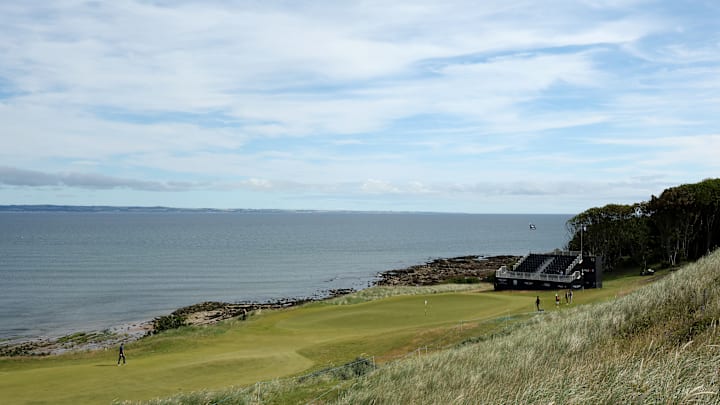After a thrilling finish at the John Deere Classic, the PGA Tour heads across the pond for the Genesis Scottish Open, an event co-sanctioned by the DP World Tour at The Renaissance Club.
The Renaissance Club is a newer venue, designed in 2008 by brilliant architect Tom Doak. While it isn't as historic as the old links courses nearby, this layout incorporates the look and style of traditional British links, which I discuss further in my podcast, Linksworms.
The Renaissance Club is a gorgeous modern links layout with an old feel
Memorable Holes: 8.0
The most dazzling holes at The Renaissance Club are found on the back nine, particularly holes 12 through 14, which take golfers to the edge of the North Sea and around the ancient stone wall that runs through the property.
The 12th and 14th are par-3s, which we will discuss later, but the 13th is a stunning 418-yard par-4. This bunker-free dogleg left hugs the North Sea coastline, and the green in particular is dangerously close. Any approach shots that miss left will become souvenirs on the beach.
Interest: 6.5
Deep pot bunkers keep golfers on their toes throughout the round at The Renaissance Club. The green complexes can also be compelling, as we see on the par-3 sixth.
It only measures 147 yards, and the green is large for a hole so short, but it is heavily contoured. Three deep bunkers guard the right side, and the green has a small front section that is domed with a false front and runoff areas on all sides.
It may be a short hole, but a pin location in this front section can be perilous.
Par-3s: 7.5
There are five par-3s at The Renaissance Club beginning with the previously mentioned short sixth.
Next is the 218-yard ninth, a tough hole with a narrow raised green, two pot bunkers to the right, and a small lower section at the front of the green.
The 12th measures 204 yards, and the green is divided into two tiers by a depression that bisects the putting surface vertically. The old stone wall and the beautiful North Sea provide a great backdrop for this hole.
The 14th is only 161 yards and has a small green that's angled to the left. The front part of the green is divided into two sections, a high area on the right and a much lower bowl on the left. The stone wall sits uncomfortably close to the green on the right side.
Finally, the 17th measures 203 yards to a wide but shallow green beautifully framed by tall pine trees and guarded on the front-left side by a solitary bunker.
Difficulty: 8.0
If there is any kind of wind, The Renaissance Club is a very difficult golf course. There are many long and tight holes that demand shot making and accuracy.
The 11th is arguably the most difficult hole on the course, as it's a monstrous 511-yard par-4 with trouble the entire way. The hole bends to the right off the tee, calling for a fade to the extremely narrow landing area with fescue on both sides.
The second shot is a long iron to a deep and narrow green; the front is guarded by bunkers on both sides, and the stone wall comes into play along the right side, especially toward the back of the green.
Finish: 7.0
The final three holes at The Renaissance Club provide solid variety and excitement.
The par-5 16th comes in at 576 yards, a slight double dogleg with pot bunkers guarding the left side off the tee. The undulating fairway leads to a green with a wide entrance. There is a small back-left section that bulges out slightly, and it is guarded by one more pot bunker.
The aforementioned 17th is a quality one-shot test before reaching the very difficult par-4 18th.
At 483 yards, par is a significant challenge, as the fairway is very narrow with penalizing bunkers on both sides. The stone wall shows itself one last time as it cuts across the middle of the fairway about 350 yards from the tee.
The green is small for a longer hole, and it is slightly raised with falloffs on all sides. Par is a great score to finish the round.
Overall: 7.40
For the criteria used to determine these ratings, please click here.
